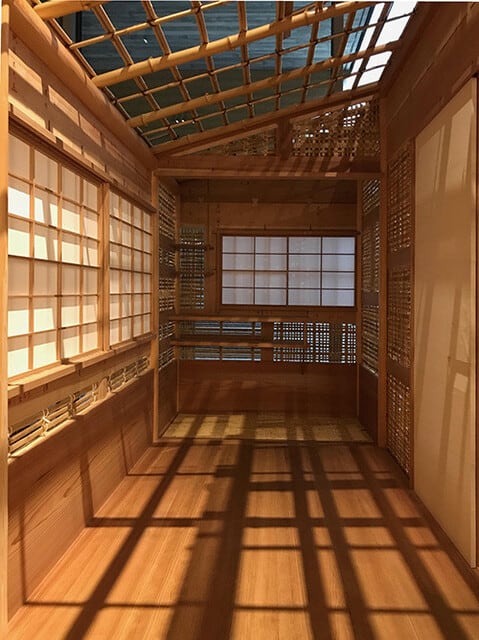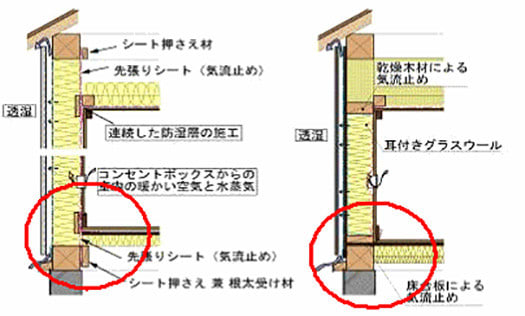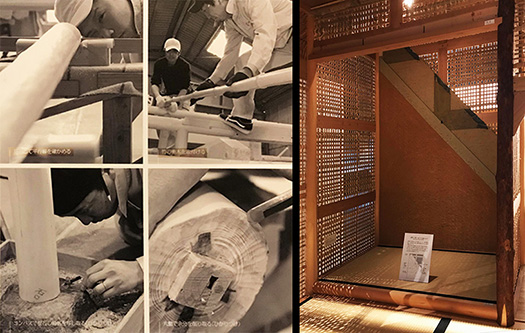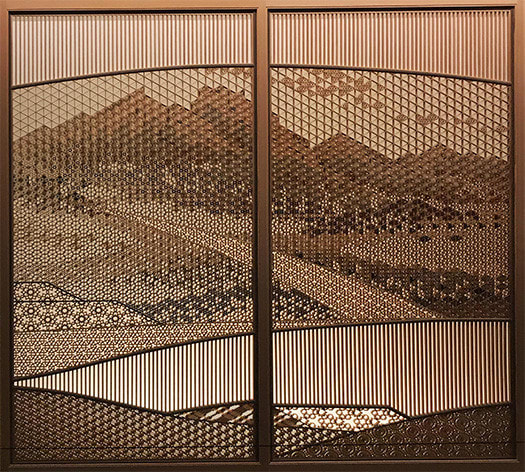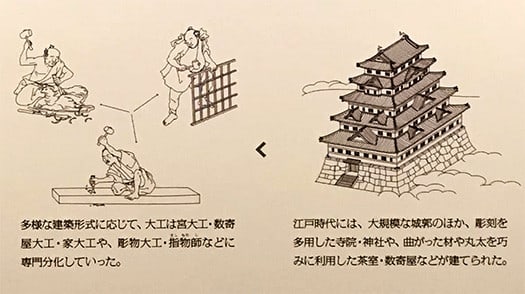
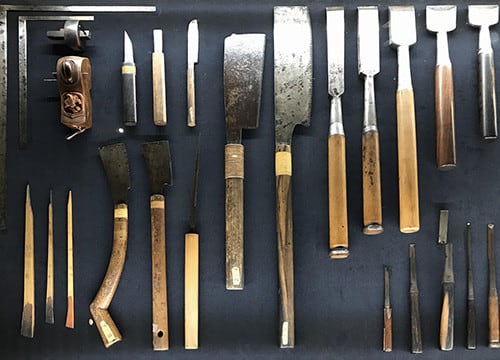
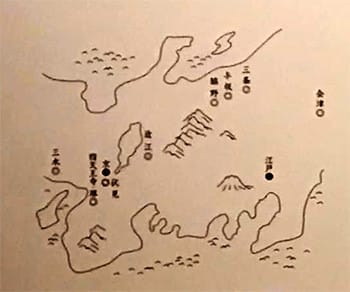
竹中大工道具館展示を長時間、見てきていますが、
やはり日本建築、大工道具から見えてくるのは表題のような世界。
日本の在来木造技術は「木組み」という木の本性と対話する技術として
そのための手段として道具を繊細に工夫するような大工技量を生んでいった。
上の写真は再度スケルトン茶室だけれど、このような芸術的な木組みを
実現可能な繊細な「表現力」までが体技化されていった。
戦国期という時代は、活発な大航海時代という世界交流の時代であり
鉄砲に代表される西洋近代合理主義も導入されて日本では技術の上でも
ビッグバンのような状況があったのだと思える。
安土城を嚆矢とするオリジナル建築をも生み出したパワー。
それを引き継いだ江戸期は鎖国という条件の下で、
その西洋合理主義の実質も織り込んだような技術が追求されていった。
こうした大工道具類は3番目の日本地図のように
「金物生産の名産地域」の名を残すまでになっていた。
製鉄は中国地方の「おろち」伝承に見られるように国内で盛んになった産業。
ある時期まで日本社会が強く朝鮮半島に関与してきたのは
製鉄が主要部分で技術も含めて大陸・半島社会に依存していたことを証している。
それが、古墳時代か飛鳥の時代以降、具体的には白村江敗戦以降
製鉄が国内で賄われるようになって、半島への興味が薄らいでいく。
鉄の原料の調達から国内生産までが一貫して国産化した。
原料発掘は派生的に石見の銀や奥州の金発掘までもたらした。
白村江での敗戦はむしろ内製化を促進させた最大のきっかけだったのかも知れない。
そして戦国期の活発な内戦状況は武器生産技術をさらに加速し、
全国にそのような工房施設拠点が作られていった。
江戸期になってそういった鉄生産技術は大工道具の世界にも波及したのだろう。
数寄屋茶室のような繊細な建築表現を可能にする
道具の進化は、鉄器生産の高度化と共鳴していったことだろう。
図の2重◎地域がそういった地域に当たるけれど、
大工道具の心臓部である鉄の造形、品質をコントロールしてきた。
兵庫県では縁のある「三木」の地名が見えています・・・。
「大工の腕を見るにはその道具を見る」というのは格言化されているけれど、
木造技術のディテールで努力していけば自ずとより専用的なを求めるようになり
その入手のためには多様な人間関係を構築して
「情報ネットワーク」も不可欠になっていく。
各地を転々とした大工職人を採用する大工棟梁は
こうしたすべてを面接して技量を計っていたに違いない。
こういった繊細化が大工技術に於いても生起した江戸期鎖国体制。
このことのメリットデメリットのすべてが今日の日本社会の背景にある。
大工道具の深遠さに日本人の本然が見えてくる気がします。
English version⬇
[A world where you can understand your skills by looking at tools / A good house in Japan ㊳-17]
I've been watching the Takenaka Carpentry Tools Museum exhibition for a long time,
After all, what you can see from Japanese architecture and carpentry tools is the world like the title.
Japanese traditional wooden technology is a technology that interacts with the nature of wood called "wooden construction".
As a means for that, he created a carpentry skill that delicately devised tools.
The photo above is again a skeleton tea room, but with such an artistic timber frame
Even the delicate "expressive power" that can be realized has been made into a physical skill.
The Warring States period is an era of world exchange, the age of active voyages.
Western modern rationalism represented by guns was also introduced, and in Japan, even in terms of technology
I think there was a situation like the Big Bang.
The power that created the original architecture with Azuchi Castle as the starting point.
During the Edo period, when it was taken over, under the condition of isolation,
A technique that incorporates the substance of Western rationalism was pursued.
These carpentry tools are like the third map of Japan
It had left the name of "a specialty area for hardware production".
Ironmaking is an industry that has flourished in Japan, as seen in the tradition of "Orochi" in the Chugoku region.
Until a certain time, Japanese society was strongly involved in the Korean Peninsula.
It proves that steelmaking relied on continental and peninsular societies, including technology, in the main part.
That was after the Kofun period or the Asuka period, specifically after the Battle of Baekgang.
As iron making becomes domestically covered, interest in the peninsula diminishes.
From the procurement of iron raw materials to domestic production, it has been consistently domestically produced.
The excavation of raw materials has resulted in the excavation of silver in Iwami and gold in Oshu.
The defeat at Baekgang may have been the biggest reason for promoting in-house production.
And the active civil war situation during the Warring States period further accelerated weapon production technology,
It seems that such workshop facility bases were created all over the country.
In the Edo period, such iron production technology would have spread to the world of carpentry tools.
After all it enables delicate architectural expression like Sukiya tea room
The evolution of tools would have resonated with the sophistication of ironware production.
Double in the figure ◎ The area corresponds to such an area,
We have controlled the molding and quality of iron, which is the heart of carpentry tools.
In Hyogo prefecture, you can see the place name of "Miki", which has a connection.
"To see the carpenter's arm, look at the tool" is a maxim,
If you work hard with the details of wooden technology, you will naturally seek more dedicated.
Build diverse relationships to get it
"Information networks" will also become indispensable.
The carpenter builder who hires carpenters from all over the world
He must have interviewed all of these and measured his skills.
The Edo period isolation system where such delicacy occurred even in carpentry technology.
All of the advantages and disadvantages of this are behind today's Japanese society.
I feel that the true nature of Japanese people can be seen in the depth of carpentry tools.












